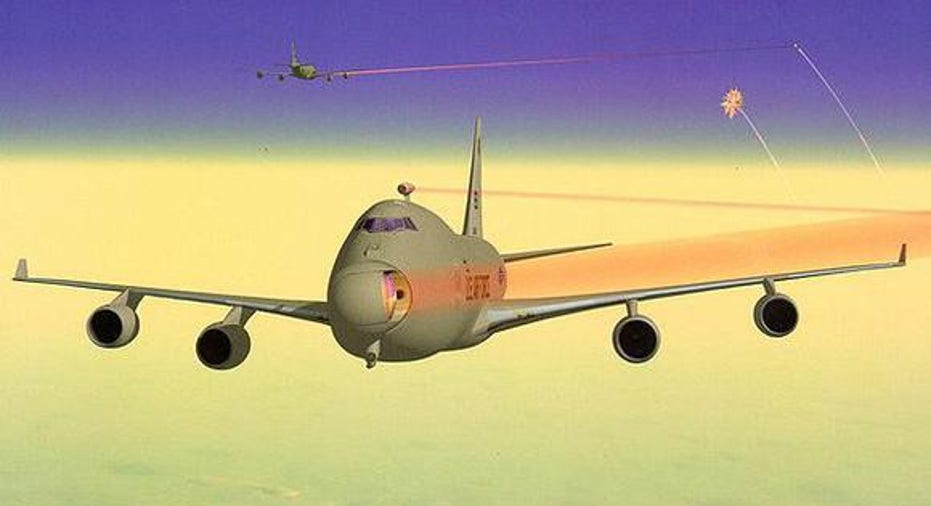Air Force Wants Boeing to Build It a Laser Cannon

It seems like only yesterday that the U.S. Air Force was asking Boeing (NYSE: BA) to build it a laser cannon. In fact, it was more than a decade ago.
12 years ago, the U.S. Air Force tried to turn a Boeing 747 into an airborne laser. Now they're ready to try it on fighter jets. Photo source:Wikimedia Commons.
12 years ago -- almost to the day -- one of the very first articles I penned for The Motley Fool was a piece on the Air Force's Air-Borne Laser (ABL) program, a half-crazed plan to cram a massive Chemical Oxygen Iodine Laser, the size of two tractor-trailers, onto a Boeing 747, and use it to shoot ICBMs out of the sky. Ultimately, the Pentagon gave up on its ABL dream, dashing the hopes of defense contractorsBoeing and Lockheed Martin (NYSE: LMT), Northrop Grumman (NYSE: NOC), and Raytheon (NYSE: RTN), who had all teamed up to build it.
12 years on, everything old is new again. Once again, the Pentagon is reaching out to all its favorite contractors and asking them to build it a flying laser gun -- and this time, they just might pull it off.
Laser guns 2.0
12 years ago, with military laser technology still in its infancy, the Air Force needed a 747 to tote one of these things around. But thanks to advancements in miniaturization, we've now reached a point where the Air Force says it's feasible to load a 5,000-lb. high energy laser onto a Lockheed Martin C-130 gunship and begin taking potshots at targets of opportunity -- at 180 to 200 kilowatts a pop. Not long after, the plan will be to continue miniaturizing the gun to the point that it will fit on board a fighter jet.
The Pentagon asked Northrop Grumman to begin work on this project four months ago, awarding Northrop $39.3 million to develop a "beam director turret" for a laser gun that could shoot down incoming missiles. Last week, the Pentagon took the next step when it awarded Boeing $90 million to develop a laser "pod". In each case, the Air Force asked the companies to complete their work before the end of 2021 -- suggesting an intention to begin installing lasers on fighter jets not long after beginning to test laser cannons on the AC-130 in 2020.
What it means for investors
It's hard to overestimate the importance of these contracts for investors -- over the long term. Counting up all the F-16, F-15, and F-18 fighter jets in the arsenals of the U.S. Air Force, Navy, and Marine Corps alone, there are nearly 2,000 aircraftthat could potentially be armed with defensive anti-missile laser weapons, such as the ones the Northrop and Boeing contracts are designed to develop.
That's not counting the hundreds of such airplanes flown by U.S. allies around the world, which could similarly be equipped with lasers -- or the thousands of fifth-generation F-35 stealth fighter jets already starting to come off the production line to replace these fourth generation warbirds. With such a huge installed base of potential laser weapon "platforms," the revenue opportunity for lasers runs quickly into the billions of dollars, even if the weapons cost no more than $1 million per unit. (They could cost much more.)
That opportunity lies at least five years out, however, and will probably take decades to realize in full, as hundreds or thousands of fighter jets wait in line for their chance to get outfitted with laser "pods". The nearer term market opportunity is considerably smaller -- but still worth mentioning.
So far, we've seen development contracts awarded for a beam director turret and a laser pod -- but according to Lockheed Martin, these comprise just two out of six essential components needed to create a working laser weapon. Still needed are a "beam control" unit to accurately aim and target the laser, a "power supply" to feed it, a "system control" mechanism, and an "integrating structure" to slot all these components into. How much it will cost to build these parts, and who will win the contracts to develop them, remains to be seen. But we'll be watching and waiting for the answers -- and as soon as we know, you'll know.
10 stocks we like better than Boeing When investing geniuses David and Tom Gardner have a stock tip, it can pay to listen. After all, the newsletter they have run for over a decade, Motley Fool Stock Advisor, has tripled the market.*
David and Tom just revealed what they believe are the 10 best stocks for investors to buy right now... and Boeing wasn't one of them! That's right -- they think these 10 stocks are even better buys.
Click here to learn about these picks!
*Stock Advisor returns as of Nov. 7, 2016
Fool contributorRich Smithdoes not own shares of, nor is he short, any company named above. You can find him onMotley Fool CAPS, publicly pontificating under the handleTMFDitty, where he's currently ranked No. 346 out of more than 75,000 rated members.
The Motley Fool has no position in any of the stocks mentioned. Try any of our Foolish newsletter services free for 30 days. We Fools may not all hold the same opinions, but we all believe that considering a diverse range of insights makes us better investors. The Motley Fool has a disclosure policy.



















